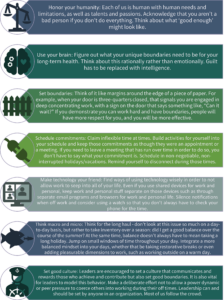66% of full-time employees in the United States don’t believe they have a healthy work-life balance. Without this balance (or perceived balance), employees become burned out. Burned out employees have lower levels of productivity and morale. While one might think that it is the responsibility of the employees to create the balance for themselves, it has become essential for employers to establish a work culture that promotes work-life balance if they hope to retain employees.
Start by taking a look at what is causing an imbalance for employees at your organization. This can vary from person to person, but the following are typical causes:
- Rising expenses: Generally, for middle-class people, expenses continue to rise while salaries and wages stay stagnant.
- Increased workplace responsibilities: Employees find they have more responsibilities at work than they can complete during their shifts.
- Longer hours: Some employees work extended hours either to ensure they complete all their tasks or to make extra money to cover their expenses.
- Growing personal responsibilities: Many employees find their home responsibilities increase as they purchase homes, get married, have children, and take care of aging relatives.
- Unsupportive supervisors: Some employees have supervisors who do not support their personal needs, making it a challenge to manage both work and home responsibilities.
Managers have to set the tone and normalize conversations around work-life balance. Employees should feel comfortable discussing boundaries with each other.
- Know what your employees are looking for. Not everyone has the same work-life balance goals. Talk to each employee about their objectives, and then determine what you can do to help them. Some employees may benefit from working remotely a couple of days each week, while others may prefer altering their daily work schedule. It’s important to be open-minded and flexible.
- Set a good example. Your employees follow your lead. If you send emails at all hours of the day and night or work hard on the weekends, your staff thinks that is what is expected of them, too.
- Let employees know what their options are. While employers typically do a good job of highlighting their work-life balance offerings to prospective job candidates, the same isn’t necessarily true for communicating those initiatives to current employees. Regularly discuss with your employees the options that are available to them.
- Stay at the forefront. It is important to keep ahead of the curve on emerging work-life balance trends. What works today for employees might not be a good fit a year from now. Keep your work-life balance initiatives fresh and offer in-demand benefits.
The following are suggested strategies managers and employees can use to create work-life balance.

